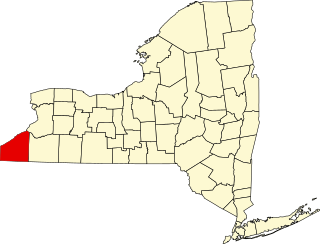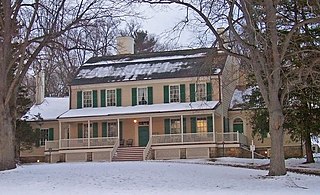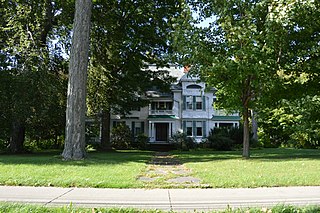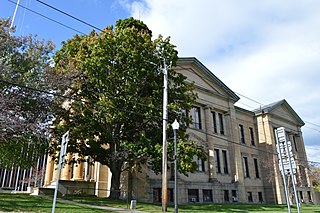
Chautauqua is a town and lake resort community in Chautauqua County, New York, United States. The population was 4,464 at the 2010 census. The town is named after Chautauqua Lake. The traditional meaning remains "bag tied in the middle". The suggested meanings of this Seneca word have become numerous: "the place where one is lost"; "the place of easy death"; "fish taken out"; "foggy place"; "high up"; "two moccasins fastened together"; and "a bag tied in the middle".

The Chautauqua Institution is a nonprofit education center and summer resort for adults and youth located on 750 acres (3 km²) in Chautauqua, New York, 17 miles (27 km) northwest of Jamestown in the southwestern part of New York State. The Chautauqua Institution Historic District is listed on the National Register of Historic Places and was further designated a National Historic Landmark.

The William Cullen Bryant Homestead is the boyhood home and later summer residence of William Cullen Bryant (1794–1878), one of America's foremost poets and newspaper editors. The 155-acre (63 ha) estate is located at 205 Bryant Road in Cummington, Massachusetts, currently operated by the non-profit Trustees of Reservations, and open to the public on weekends in summer and early fall. An admission fee is charged.

This is a list of the National Register of Historic Places listings in Chautauqua County, New York.

Midway State Park, located in Maple Springs, New York, was established in 1898 by the Jamestown & Lake Erie Railway as a picnic ground. Today, it is recognized as the fifteenth-oldest continually operating amusement park in the United States, and the fifth-oldest remaining trolley park of the thirteen still operating in the United States.

The Wyckoff-Bennett Homestead, located at 1669 E. 22nd Street in Madison, Brooklyn, New York, is a National Historic Landmark. It is believed to have been built before 1766. During the American Revolution, it housed Hessian soldiers, two of whom, Captain Toepfer of the Ditfourth regiment and Lieut. M. Bach of the Hessen-Hanau Artillerie, scratched their names and units into windowpanes.

John Jay Homestead State Historic Site is the home of statesman John Jay, first Chief Justice of the United States, located in Katonah, New York. Also known as Bedford House and John Jay House, it is a New York State Historic Site and National Historic Landmark.

The Homestead in Geneseo, New York is a historic house that was listed on the National Register of Historic Places in 1974. It is also a contributing property within the Geneseo Historic District, and is described in the district's National Historic Landmark nomination. The house was built by William Wadsworth, and continues to be owned by the Wadsworth family of Geneseo, New York.

Samuel Frederick Nixon was an American businessman and politician.

The Reynolds Homestead, also known as Rock Spring Plantation, is a historic plantation on Homestead Lane in Critz, Virginia. First developed in 1814 by Abraham Reynolds, it was the primary home of R. J. Reynolds (1850-1918), founder of the R. J. Reynolds Tobacco Company, and the first major marketer of the cigarette. It was designated a National Historic Landmark in 1977. The homestead is currently an outreach facility of Virginia Tech, serving as a regional cultural center. The house is open for tours.

Harriet Campbell-Taylor House is a historic home located at Westfield in Chautauqua County, New York. It is a two-story brick Italianate and Greek Revival style dwelling built in 1850.

Reuben Gridley Wright Farm Complex is a historic home and farm complex located at Westfield in Chautauqua County, New York. The home is a two-story wood frame Queen Anne style dwelling built in 1883 for Rueben Gridley Wright, one of Westfield's most prominent citizens. The property includes five contributing farm outbuildings that relate to its operation as a, extensive late 19th century vineyard operation.

The Samuel F. Nixon Homestead', or simply the Nixon Homestead, is a historic home located in the Village of Westfield in Chautauqua County, New York. The original house was built in 1856 and subsequently expanded in about 1890 to its current size and style.

Ward House, also known as the William Allen House, is a historic home located at Westfield in Chautauqua County, New York. It is a 2-story, L-shaped brick Italian Villa–style residence built in the late 1860s. The home features a prominent cupola, and the property has a 1 1⁄2-story frame barn.

Welch Factory Building No. 1 is a historic grape juice factory located at Westfield in Chautauqua County, New York. It was built in 1897 and expanded in 1899 and 1903, to be an 8-bay wide, 10-bay deep rectangular building. It is the oldest extant structure associated with the Welch's company.

East Main Street Historic District is a national historic district located in C Westfield in Chautauqua County, New York. It is an approximately 28-acre (110,000 m2) district encompassing 20 buildings and the Westfield Cemetery located along East Main Street. A number of the structures are in the Italianate and Colonial Revival styles. Candlelight Lodge was built in 1851 by a prominent Philadelphia architect as a private home, the property encompassing a good portion of the east half of the Village of Westfield. Candlelight became a lodge in the 1920s and a bed and breakfast in 1986. Candlelight Lodge is a seven bedroom Victorian mansion currently on a two-acre lot in the Village of Westfield. Candlelight also has the Captain Storm House, a Queen Anne Victorian home moved on to this property in 2000 with the assistance of the National Historic Trust and listed on the National Resister of Historic Places.

Stone-Tolan House is a historic home located at Brighton in Monroe County, New York. The 2-story frame house has a 1-story frame wing that is believed to have been built in 1792. It is a vernacular Federal-style structure and served as a frontier tavern, public meeting place, and pioneer homestead. The Landmark Society of Western New York acquired the property in 1956 to restore and preserve as a museum.

The McClurg Museum is a renovated mansion in Westfield, New York that serves as the home of the Chautauqua County Historical Society. It is a volunteer-run museum containing various artifacts collected by the historical society along with an extensive library and photo collection. It is open to the public and local schools for educational purposes.

The Perkins Homestead, also known as the Brick House, is a historic homestead at 478 River Road in Newcastle, Maine. The 57-acre (23 ha) property, including its 1837 brick farmhouse, was designated a National Historic Landmark for its association with the life of Frances Perkins (1880–1965), the first woman to hold a position in the United States Cabinet. Perkins spent many years, both as a child and later as an adult, at this property, which she considered to be her true home. The property was first listed on the National Register of Historic Places in 2009 as the Brick House Historic District in part for its archaeological significance.



























